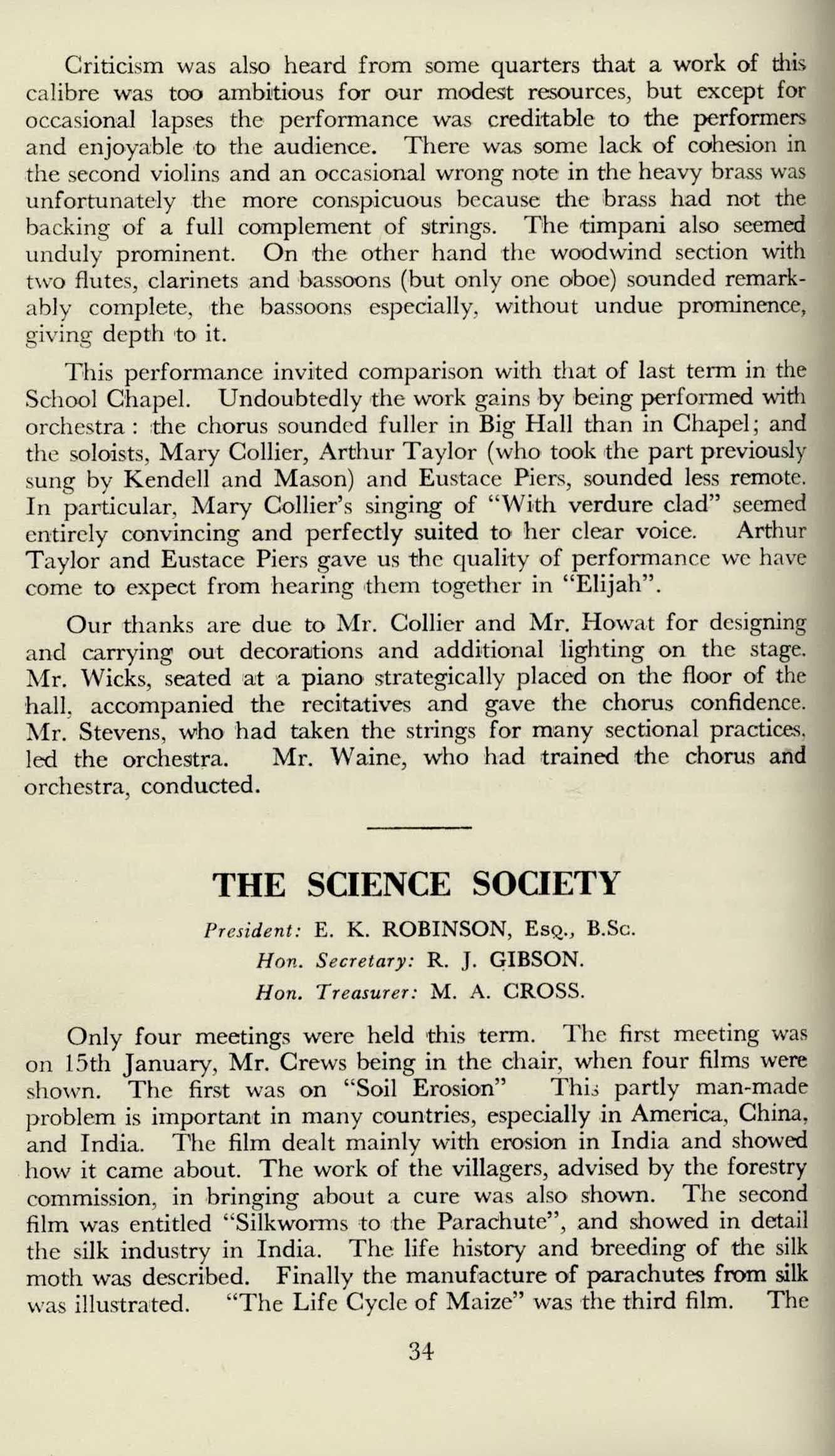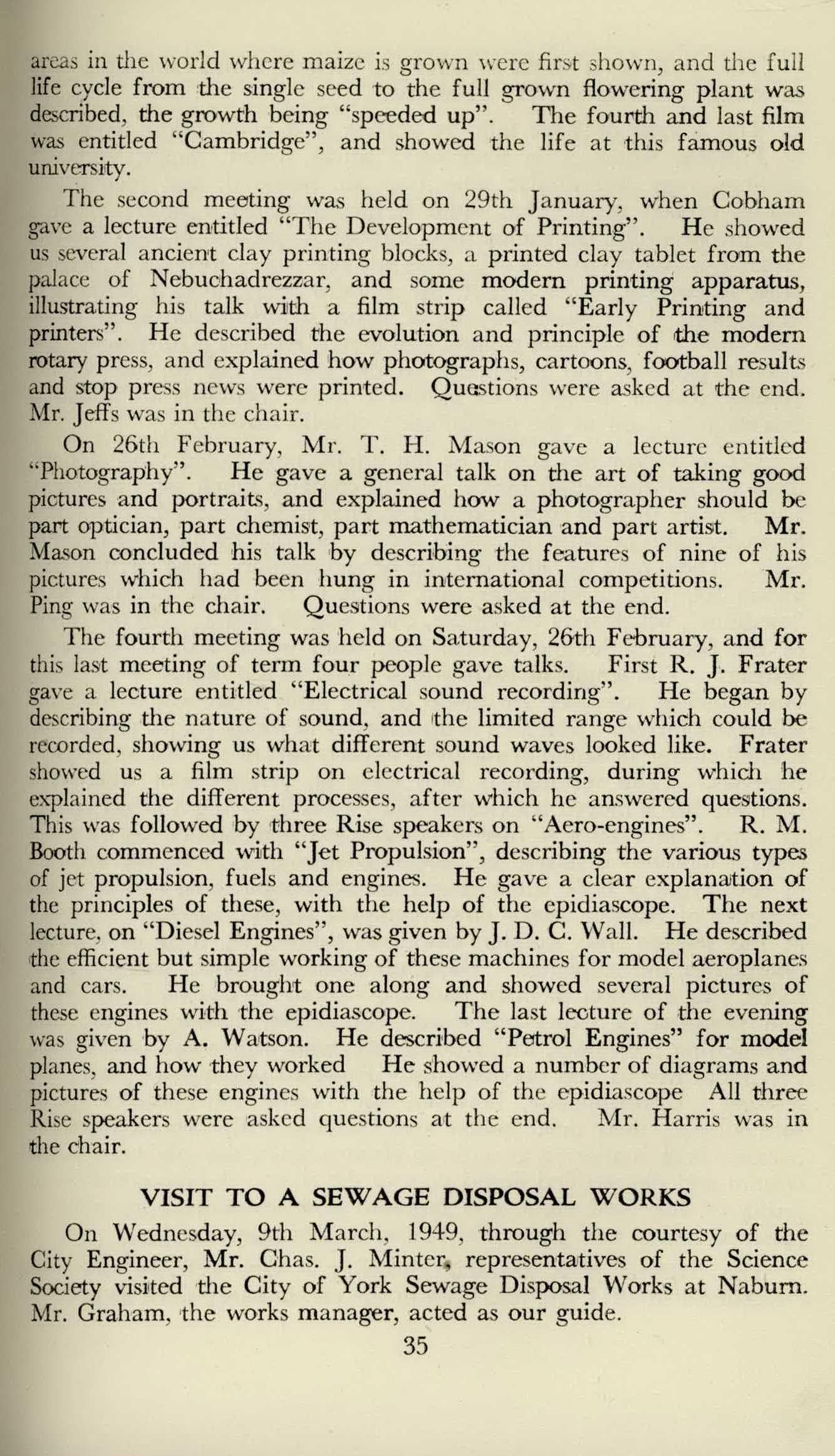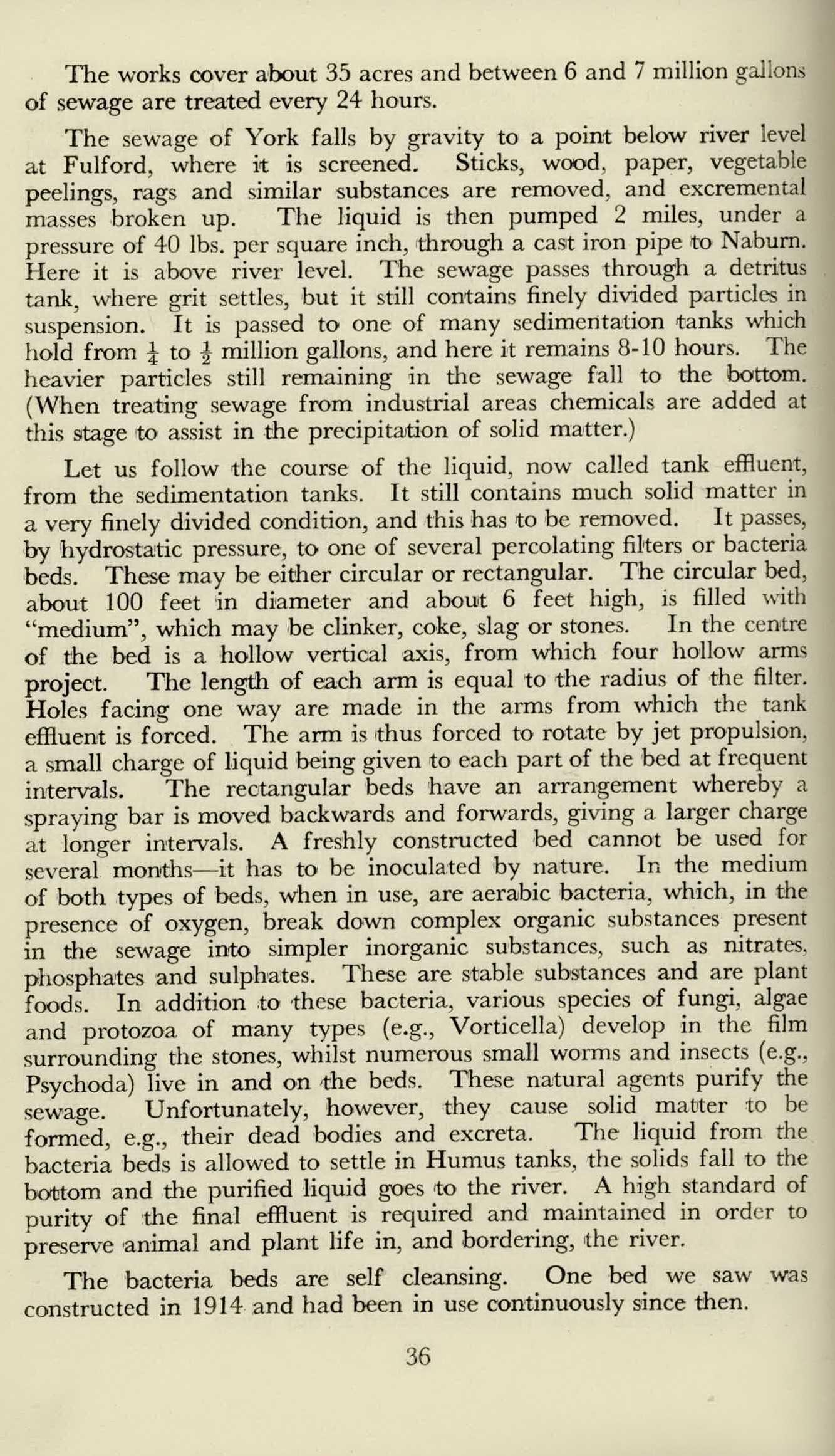
7 minute read
The Science Society
from May 1949
by StPetersYork
Criticism was also heard from some quarters that a work of this calibre was too ambitious for our modest resources, but except for occasional lapses the performance was creditable to the performers and enjoyable to the audience. There was some lack of cohesion in the second violins and an occasional wrong note in the heavy brass was unfortunately the more conspicuous because the brass had not the backing of a full complement of strings. The timpani also seemed unduly prominent. On the other hand the woodwind section with two flutes, clarinets and bassoons (but only one oboe) sounded remarkably complete, the bassoons especially, without undue prominence, giving depth to it.
This performance invited comparison with that of last term in the School Chapel. Undoubtedly the work gains by being performed with orchestra : the chorus sounded fuller in Big Hall than in Chapel; and the soloists, Mary Collier, Arthur Taylor (who took the part previously sung by Kendell and Mason) and Eustace Piers, sounded less remote. In particular, Mary Collier's singing of "With verdure clad" seemed entirely convincing and perfectly suited to her clear voice. Arthur Taylor and Eustace Piers gave us the quality of performance we have come to expect from hearing them together in "Elijah".
Our thanks are due to Mr. Collier and Mr. Howat for designing and carrying out decorations and additional lighting on the stage. Mr. Wicks, seated at a piano strategically placed on the floor of the hall, accompanied the recitatives and gave the chorus confidence. Mr. Stevens, who 'had taken the strings for many sectional practices. led the orchestra. Mr. Waine, who had trained the chorus and orchestra, conducted.
President: E. K. ROBINSON, Esca., B.Sc. Hon. Secretary: R. J. GIBSON. Hon. Treasurer: M. A. CROSS.
Only four meetings were held this term. The first meeting was on 15th January, Mr. Crews being in the chair, when four films were shown. The first was on "Soil Erosion" This partly man-made problem is important in many countries, especially in America, China, and India. The film dealt mainly with erosion in India and showed how it came about. The work of the villagers, advised by the forestry commission, in bringing about a cure was also shown. The second film was entitled "Silkworms to the Parachute", and showed in detail the silk industry in India. The life history and breeding of the silk moth was described. Finally the manufacture of parachutes from silk was illustrated. "The Life Cycle of Maize" was the third film. The
areas in the world where maize is grown were first shown, and the full life cycle from the single seed to the full grown flowering plant was described, the growth being "speeded up". The fourth and last film was entitled "Cambridge", and showed the life at this famous old university.
The second meeting was held on 29th January, when Cobham gave a lecture entitled "The Development of Printing". He showed us several ancient clay printing blocks, a printed clay tablet from the palace of Nebuohadrezzar, and some modern printing apparatus, illustrating his talk with a film strip called "Early Printing and printers". He described the evolution and principle of the modern rotary press, and explained how photographs, cartoons, football results and stop press news were printed. Questions were asked at the end. Mr. Jeffs was in the chair.
On 26th February, Mr. T. H. Mason gave a lecture entitled "Photography". He gave a general talk on the art of taking good pictures and portraits, and explained how a photographer should be part optician, part chemist, part mathematician and part artist. Mr. Mason concluded his talk by describing the features of nine of his pictures which had been hung in international competitions. Mr. Ping was in the chair. Questions were asked at the end.
The fourth meeting was held on Saturday, 26th February, and for this last meeting of term four people gave talks. First R. J. Frater gave a lecture entitled "Electrical sound recording". He began by describing the nature of sound, and the limited range which could be recorded, showing us what different sound waves looked like. Frater showed us a film strip on electrical recording, during which he explained the different processes, after which he answered questions. This was followed by three Rise speakers on "Aero-engines". R. M. Booth commenced with "Jet Propulsion", describing the various types of jet propulsion, fuels and engines. He gave a clear explanation of the principles of these, with the help of the epidiascope. The next lecture, on "Diesel Engines", was given by J. D. C. Wall. He described the efficient but simple working of these machines for model aeroplanes and cars. He brought one along and showed several pictures of these engines with the epidiascope. The last lecture of the evening was given by A. Watson. He described "Petrol Engines" for model planes, and how they worked He showed a number of diagrams and pictures of these engines with the help of the epidiascope All three Rise speakers were asked questions at the end. Mr. Harris was in the chair.

VISIT TO A SEWAGE DISPOSAL WORKS
On Wednesday, 9th March, 1949, through the courtesy of the City Engineer, Mr. Chas. J. Minter, representatives of the Science Society visited the City of York Sewage Disposal Works at Naburn. Mr. Graham, the works manager, acted as our guide. 35
The works cover about 35 acres and between 6 and 7 million gallons of sewage are treated every 24 hours.
The sewage of York falls by gravity to a point below river level at Fulford, where it is screened. Sticks, wood, paper, vegetable peelings, rags and similar substances are removed, and excremental masses broken up. The liquid is then pumped 2 miles, under a pressure of 40 lbs. per square inch, through a cast iron pipe to Naburn. Here it is above river level. The sewage passes through a detritus tank, where grit settles, but it still contains finely divided particles in suspension. It is passed to one of many sedimentation tanks which hold from to 2 million gallons, and here it remains 8-10 hours. The heavier particles still remaining in the sewage fall to the bottom. (When treating sewage from industrial areas chemicals are added at this stage to assist in the precipitation of solid matter.)
Let us follow the course of the liquid, now called tank effluent, from the sedimentation tanks. It still contains much solid matter in a very finely divided condition, and this has to be removed. It passes, by hydrostatic pressure, to one of several percolating filters or bacteria beds. These may be either circular or rectangular. The circular bed, about 100 feet in diameter and about 6 feet high, is filled with "medium", which may be clinker, coke, slag or stones. In the centre of the bed is a hollow vertical axis, from which four hollow arms project. The length of each arm is equal to the radius of the filter. Holes facing one way are made in the arms from which the tank effluent is forced. The arm is thus forced to rotate by jet propulsion, a small charge of liquid being given to each part of the 'bed at frequent intervals. The rectangular beds have an arrangement whereby a spraying bar is moved backwards and forwards, giving a larger charge at longer intervals. A freshly constructed bed cannot be used for several months—it has to be inoculated by nature. In the medium of both types of beds, when in use, are aerabic bacteria, which, in the presence of oxygen, break down complex organic substances present in the sewage into simpler inorganic substances, such as nitrates, phosphates and sulphates. These are stable substances and are plant foods. In addition to these bacteria, various species of fungi, algae and protozoa of many types (e.g., Vorticella) develop in the film surrounding the stones, whilst numerous small worms and insects (e.g., Psychoda) live in and on the beds. These natural agents purify the sewage. Unfortunately, however, they cause solid matter to be formed, e.g., their dead bodies and excreta. The liquid from the bacteria 'beds is allowed to settle in Humus tanks, the solids fall to the bottom and the purified liquid goes to the river. A high standard of purity of the final effluent is required and maintained in order to preserve animal and plant life in, and bordering, the river.
The 'bacteria beds are self cleansing One bed we saw was constructed in 1914 and had been in use continuously since then.











